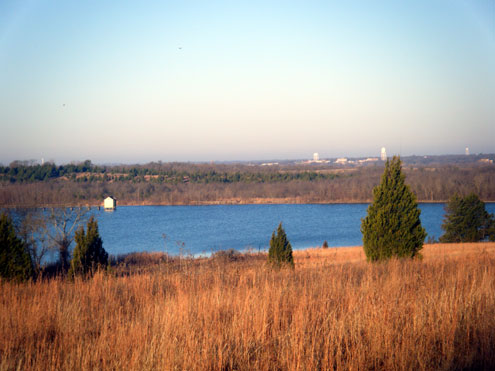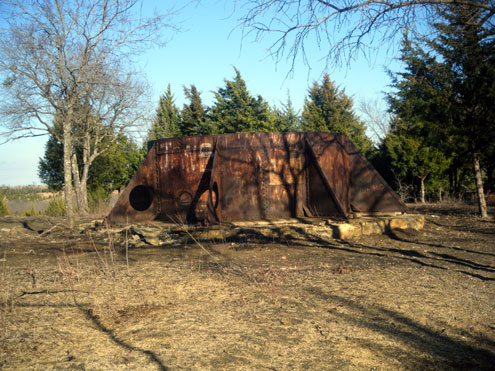 |
Red River Scrapbook
Over 100 years ago - Bonham tackles its water woes
By Tim Davis
Apr 20, 2021
Editor's note: This article originally ran in February 2010. Now that the Bois d'Arc Lake/Reservoir is a reality, it seems like a good time to run this article again, noting another time when a city, Bonham, drew water from our famous creek.
Fannin County, Texas -- Less than a decade after the smoke and dust cleared from the Civil War, the Texas and Pacific Railroad came to Fannin County and brought many changes with it. Among them was a significant increase in Bonham’s population. According to U. S. Census records, its population in 1840, when its name was Bois d’ Arc, was 477. By 1890 it was more than seven times larger with 3,361 people.
As any city planner will tell you, such an increase in population places a strain on city services, including the ability to provide citizens with clean water.
For roughly the first fifty years of its history, the city of Bonham relied on wells to provide water. For thirty years the system perhaps worked just fine. However, once the railroad hit town in 1873, problems arose.
To say that the whole system was in terrible shape by the mid 1880s would be an understatement. Perhaps the Sanborn Fire Insurance map for 1885 said it best when it labeled the water facilities as “not good.” Subsequent Sanborn maps, published in 1888 and 1892, said the same.
City leaders struggled with the situation. There are plenty of newspaper clippings from 1887 to 1892 documenting the digging of more wells. Unfortunately, those efforts proved futile.
1893 was the watershed year. As reported in the January 28 Dallas News, the Bonham city council gave up on drilling wells and focused instead on creating an artificial lake.
By early spring a location had been chosen. The May 28 News reported that the “site of the lake is about two miles east from the city across Bois d’ Arc creek where they intend to build a high dam, which when completed, will make a lake covering sixty acres of land with an average depth of sixteen feet.”
By July 2 the News reported that the city had “possession of deeds to the land from the owners at a cost of nearly $8,000. The land purchased is 200 acres. Work will begin at an early date.” By July 10 it noted that the city “would build the dam instead of letting it out to a contractor.”
In mid July work on the lake started. The News of July 14 noted that engineer W. C. Dean had “thirty-three hands busy clearing off the brush and undergrowth.” It further noted that the crew had “killed eleven snakes. The species killed were rattlesnakes and water moccasins, consequently, Engineer Dean superintends from the back of a horse.”
The August 10 Dallas News reported that the city “had purchased five miles of piping at a cost of $12,000. They have also ordered a standpipe and boilers at a cost of $8,233.” It noted that the “standpipe will be 110 feet high and 16 feet in diameter.”
By mid fall evidence of improvements in the waterworks system could be seen downtown. The November 11 News noted that the “waterworks committee has a large force at work on the public square for the water mains of the waterworks.” With reference to the lake area itself, it reported that the “dam is about completed, the foundation for the standpipe is being built.”
By early spring of 1894 all seemed ready to go. The March 30 Dallas News reported: “The standpipe at the waterworks was completed yesterday. Work is progressing rapidly and the authorities will soon be able to make a test of the works.”
In its May 14 meeting, the Bonham City Council adopted the rules governing the new system. The minutes note the passing of an “ordinance providing for the collection of water rates, the election of a Board of Water Commissioners and other regulations necessary for operating the Bonham City Waterworks.”
All things considered, it’s safe to assume that water was flowing in Bonham by mid 1894.

By 1897 the city council decided to supplement the new waterworks system from another source. The March 23 Dallas News reported: “To increase the volume of water in the reservoir a large pump has been stationed on the bank of Bois d’ Arc creek and a four inch water main has been laid from the creek to the reservoir . . . .” The pump, it further noted, “will continue to run night and day . . . thereby increasing the volume of water every twenty-four hours 1,000,000 gallons.”
In other words, when Bois d’ Arc Lake becomes reality, it will not be the first time for the county’s most famous creek to provide water for an incorporated city.
Over time Bois d’ Arc Creek would continue to be a secondary source of water. The January 13, 1899 Bonham News reported that “piping to lay a main from Bois d’ Arc creek to the city pool has been received and will be laid as soon as possible.”
It appears that 1910 was the last year that city leaders turned to Bois d’ Arc Creek for help. The minutes of the April 11 city council meeting state: “On motion it was decided to begin at once the work of laying of pipe line from pumping station on Bois d’ Arc to the city lake.” Late to mid April issues of the Bonham Daily Favorite noted that the new mains were “ten inches in diameter,” and that the new line would “put 2,000,000 gallons of water in the lake every twenty four hours.”
Referring to they city’s ongoing water shortage issues, the April 26 Daily Favorite noted: “The work of laying these mains will be pushed as rapidly as possible, and when completed will possibly solve the water problem that has so long confronted the city.”
It is worth noting that the Sanborn Fire Insurance maps for 1897, 1902 and 1909 also refer to the pumping of water from Bois d’ Arc to the city lake.
All evidence indicates that by 1930 the city had stopped using water from the city lake and standpipe, except maybe in emergency situations. The 1932 Sanborn Fire Insurance map notes that the city was using only a combination of wells and a new 300,000 gallon water tower located down town.
So why did the city pretty much abandon the lake/standpipe combination in 1930? And how did the new water tower figure into that decision? And what local industry began using the water supply from the old lake and standpipe? With reference to these questions, I urge readers to please be patient. They will be answered in a subsequent article.
 |
Anyone with photographs of the old standpipe is urged to contact me at (903)227-1772 or mail to: davis.mark.tim@gmail.com.